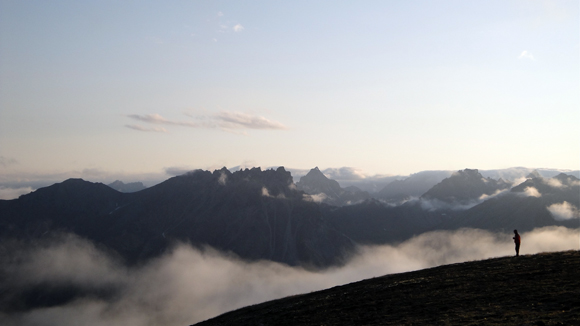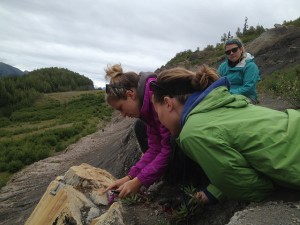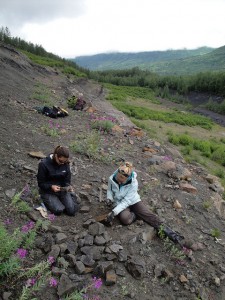
The Matunuska Valley in Alaska
David Sunderlin has a special connection to Alaska, one that dates back 55 million years.
The associate professor of geology studies fossil leaves and wood caught in the sedimentary record of Alaska’s Matanuska Valley with the hopes of contextualizing the environment of the past with the future.
The fossils he and his student researchers study are from the end of the Paleocene Epoch and the beginning of the Eocene Epoch, a time when the global climate was the warmest it has been since the demise of the dinosaurs. His research group has shown that the climate of Alaska at that time seems to be much like modern Virginia, or the Carolinas.
“We can see this by the kinds of tree leaves and insects we are finding,” he says. “If we understand how high-latitude ecosystems were constructed during ancient “greenhouse” conditions, that shows us a time when the Arctic was a very different place, and we can then learn how it might become different under climate change in the future.”

Jaclyn White ’13 inspects a piece of petrified wood.
Geology graduates Jaclyn White ’13 and Alexandria Brannick ’12 spent the summer of 2011 in the field with Sunderlin in Alaska through Lafayette’s EXCEL Scholars undergraduate research program. White worked on reconstructing the paleoclimate using the fossil leaves and wood, and Brannick studied the paleoecology of plant/insect interactions.
Brannick, who is working on her Ph.D. at the University of Washington, wrote her senior thesis about her fieldwork in Alaska.
“We learned that Alaska’s ecosystem then was different than it is today. And that when compared to regions closer to the equator, even though the temperatures were about the same, there was much less insect herbivory in Alaska.” she says, referring to practice of eating plants. “The insect herbivory may have had more to do with latitude than climate.”
White also ventured to Alaska in the summer of 2012. She and other students reconstructed environmental parameters preserved in the Chickaloon and Arkose Ridge formations by collecting fossilized trees and comparing their rings to modern redwoods.
As is typical with a liberal arts education, the students learned much more from Sunderlin than just the subject of the research.

Alexandria Brannick ’12, left, sorts fossil leaves from Alaska’s Chickaloon Formation.
“He’s had an immense influence on my career,” says White, who is getting her master’s in geology at University of Connecticut. “He introduced me to research. Now, I know how to do things that I didn’t realize Dr. Sunderlin was teaching me. I had to do my own field project in Wyoming and Montana this past summer, and he actually taught me how to plan for that, how to plan your meals, where to camp.”
Sunderlin’s current research assistant, geology major and EXCEL Scholar George Tillery ’17 (Tucson, Ariz.), is going to use a new form of measurement that will take silhouettes of the fossilized Alaskan leaves to understand how much rain fell there during the Paleocene/Eocene.
Although he won’t be going to Alaska this summer, Tillery will accompany Sunderlin in some “reconnaissance paleontology” in northern New Mexico. Sunderlin’s hope is that trip will be a precursor to a multi-season project focused on paleo-temperature and paleo-precipitation of the region during this major “greenhouse climate phase” in the late Paleocene/early Eocene epochs.
“Just like the Arctic, the Desert Southwest is quite sensitive to climate change,” says Sunderlin. “What can the rocks there tell us about its ancient environmental history?”



2 Comments
Every student should read Prof James Dyson’s book “The World of Ice”
Every body should read Professor James Dyson’s book
“The world of Ice”
Comments are closed.